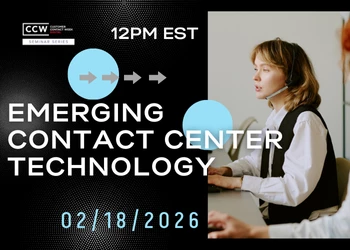4 Key Predictions about the Contact Center of 2025
Leaders from customer contact, marketing, IT and the C-suite share their plans, visions and concerns
Add bookmarkWe’re consistently told in business that if you’re not ahead of the competition, you’re falling behind. Sink or swim. Lead or lag. These unflinching stakes have pushed contact center leaders to shift from an emphasis on service to an emphasis on providing an experience.
As we head into 2020, we surveyed leaders in the contact center, marketing, customer experience, IT, and the C-suite from July-October this year to hear about their predictions for the contact center of 2025 for our Market Study on the Contact Center of 2025: A Road Map.
Here’s a sneak peek into the four most surprising findings.
1. Contact centers want to shatter negative stereotypes
Flying long-haul, visiting the DMV, and calling a contact center – these three things are generally regarded as unpleasant experiences. As contact center leaders look ahead to 2025, foremost on their minds is eliminating consumers’ conditioned expectations of being put on hold, transferred multiple times, getting stuck in an IVR that prevents them from reaching a live agent, and having to repeat information over and over. Fifty-three percent of the respondents we surveyed say it’s crucial to debunk these stereotypes by 2025.
Read more: Market Study on the Contact Center of 2025 - A Roadmap
Instead, their vision for the future includes a 360-degree view of the customer and a strong emphasis on design thinking within the contact center. Businesses will also have to sink a significant investment into self-service and digital channels to eliminate the longstanding stereotype that if a customer has a “real” problem and wants a timely resolution, they have to call.
Initiatives like these are key to reforming general perceptions of the contact center. Our 2019 Consumer Preferences Survey revealed that only 11 percent of customers believe businesses take their feedback seriously.
2. The phone isn’t going anywhere
Despite a wave of literature – mostly from voice technology providers – predicting the demise of the phone channel, 75 percent of companies ultimately expect the phone to maintain or gain significance in the years ahead. In fact, only 9 percent of contact centers actively planning to shrink headcount.
Read more: 5 Most Common Customer Complaints and How to FIX Them
Although calls are here to stay, other options like bots, agent-assisted messaging, live chat and social media will factor heavily into the experience.
3. Most organizations don’t know what to do with their data
Effective data collection is an enormous undertaking. First, organizations must decide what data they wish to collect by framing specific business problems they want to solve using data. Then they must determine how to collect that data and establish the right infrastructure for it.
The third step is figuring out how to analyze the data and mine it for actionable insights. Finally – and this is the hardest part – organizations must implement change based on those insights. This can range from simple internal process improvements all the way up to a culture reform or organizational restructuring.
Here are some of the issues organizations identified with regards to their data:
Not enough data (43%)
Not using data to personalize the experience (43%)
Not doing enough data analysis (41%)
Not doing enough to understand customer sentiment (40%)
Not doing enough to identify customer pain points and effort (39%)
Insufficient knowledge management (39%)
4. Organizations are preparing for automation
It’s happening. Eighty-one percent of the organizations we surveyed have begun preparing their teams for the automation age – but it’s not what you think. The most common measure (among 59 percent of organizations) involves coaching agents for more complex “human issues.”
Others are training agents to use new systems that can better accommodate AI and automation, including new desktops, CRM systems, routing and knowledge tools. This also involves changing workflows for back-office tasks (43 percent), preparing agents for new roles (34 percent) and re-evaluating outsourcing relationships (26 percent).
To see more of what contact center leaders expect for 2025, check out the full Market Study and join us at our upcoming online summit, Contact Center 2025: A Roadmap.




















